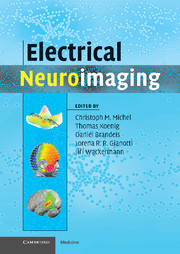Book contents
- Frontmatter
- Contents
- List of contributors
- Preface
- 1 From neuronal activity to scalp potential fields
- 2 Scalp field maps and their characterization
- 3 Imaging the electric neuronal generators of EEG/MEG
- 4 Data acquisition and pre-processing standards for electrical neuroimaging
- 5 Overview of analytical approaches
- 6 Electrical neuroimaging in the time domain
- 7 Multichannel frequency and time-frequency analysis
- 8 Statistical analysis of multichannel scalp field data
- 9 State space representation and global descriptors of brain electrical activity
- 10 Integration of electrical neuroimaging with other functional imaging methods
- Index
- References
3 - Imaging the electric neuronal generators of EEG/MEG
Published online by Cambridge University Press: 15 December 2009
- Frontmatter
- Contents
- List of contributors
- Preface
- 1 From neuronal activity to scalp potential fields
- 2 Scalp field maps and their characterization
- 3 Imaging the electric neuronal generators of EEG/MEG
- 4 Data acquisition and pre-processing standards for electrical neuroimaging
- 5 Overview of analytical approaches
- 6 Electrical neuroimaging in the time domain
- 7 Multichannel frequency and time-frequency analysis
- 8 Statistical analysis of multichannel scalp field data
- 9 State space representation and global descriptors of brain electrical activity
- 10 Integration of electrical neuroimaging with other functional imaging methods
- Index
- References
Summary
Introduction
In order to try to understand “how the brain works,” one must make measurements of brain function. And ideally, the measurements should be as noninvasive as possible, i.e. the brain should be disturbed as little as possible during the measurement of its functions. One of the first types of noninvasive measurements reported in the literature, by Hans Berger, that directly tapped brain function was the human electroencephalogram (EEG), consisting of scalp electric potential differences as a function of time. In fact, Berger saw the EEG as a “window into the brain.” One of Berger's first observations that showed compelling evidence of having tapped brain function was the alpha rhythm. This oscillatory activity, at around 10–12 Hz, is optimally recorded from a posterior electrode with an anterior reference. The activity is very pronounced when the human subject is with eyes closed, awake, alert, resting. By simply being instructed to perform a mental task such as overtly subtracting the number seven serially, starting at 500, the alpha activity disorganizes and almost disappears.
The main subject matter addressed in this chapter is the use of noninvasive extracranial measurements, i.e. the EEG and the magnetoencephalogram (MEG), for the estimation of the distribution in the brain of their electric neuronal generators. This can be seen as an extension of Berger's initial efforts towards developing a window into the brain.
- Type
- Chapter
- Information
- Electrical Neuroimaging , pp. 49 - 78Publisher: Cambridge University PressPrint publication year: 2009
References
- 9
- Cited by



